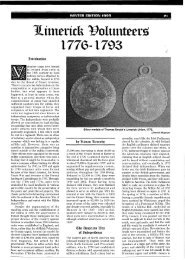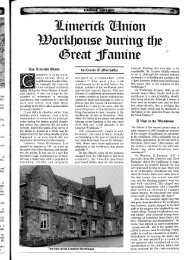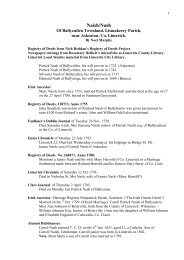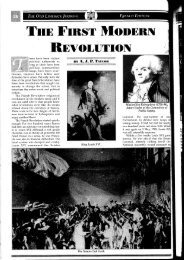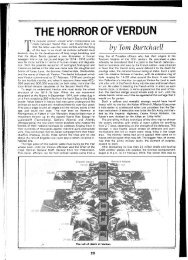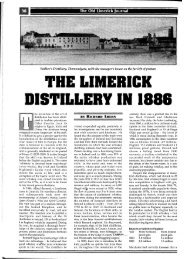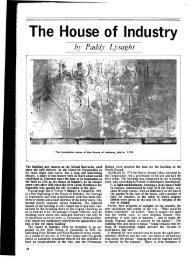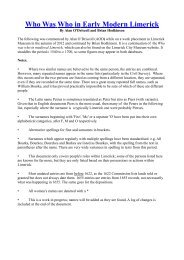pages 555 to 683 (4602 Kb) - Limerick City Council
pages 555 to 683 (4602 Kb) - Limerick City Council
pages 555 to 683 (4602 Kb) - Limerick City Council
You also want an ePaper? Increase the reach of your titles
YUMPU automatically turns print PDFs into web optimized ePapers that Google loves.
HISTORY OF LIMERICK. . .<br />
Then seriously reflect on what you see,<br />
And think on what you are now, and what you'll be ;<br />
Whether you 're greater, equal, less, you must,<br />
As well as these, be crumbled in<strong>to</strong> dust.<br />
In 1279, according <strong>to</strong> King, a general chapter of the order was held<br />
there. On the 13th of January, 1330, a " liberate" was issued for the sum<br />
of thirty-five marcs, for the payment of one year's pension <strong>to</strong> the Dominicans<br />
of <strong>Limerick</strong>, Dublin, Drogheda, Cork, and Waterford.' Nine<br />
liberates had been issued. In 1340 Gerald Rochfort, a renowned knight,<br />
and head of his sept, died on the 29th of March, and according <strong>to</strong> Ware<br />
was interred here.<br />
About this time, according <strong>to</strong> the Arthur MSS., Martin Arthur built a<br />
magnificent peristyle of marble <strong>to</strong> the church of St. Saviour in <strong>Limerick</strong>.<br />
1345, John O'Grady, Treasurer of Cashel, and for a the Rec<strong>to</strong>r of<br />
O'Griffin, in the diocese of Killaloe, succeeded by the election of Dean and<br />
Chapter <strong>to</strong> the Archbishopric of Cashel, and having procured recommenda<strong>to</strong>ry<br />
letters from the King <strong>to</strong> the Pope (dated 10th Oc<strong>to</strong>ber, 1331) was<br />
by his provision placed in that see (Cashel) in 1332. A mark", says<br />
Hogan, the author of the Annals of Nenagh '' ofgreat wisdom and industry".<br />
He died in <strong>Limerick</strong> on the 8th day of July, 1345, in the Dominican Jmbit,<br />
and was buried there in a monastery of that order. He made many<br />
donations <strong>to</strong> his church, and in that particular gave it a large pas<strong>to</strong>ral staff.'<br />
Indeed, according <strong>to</strong> the book of the Friars Preachers already referred<br />
<strong>to</strong>: the Dominican monastery of <strong>Limerick</strong> was famous, among many other<br />
circumstances, for being the place of interment of illustrious Irishmen in<br />
olden days. It was there, it adds, that its founder 'Oomcao Cuipbpouc<br />
0bpcun, as we have already stated, was Suried. It was the place of<br />
sepulture, accor?.ing <strong>to</strong> the same calendar, of De Burgo, alias bupca~.o<br />
" Dux et Capitmeus*,' as well as of many other distinguished leaders of the<br />
Irish nation, who chose it as their last resting place. Many of the<br />
Geraldines were buried there, as we learn on the same authority, and<br />
their anniversaries were commemorated with due solemnity, as is set forth<br />
in the authority in question. The second founder of this convent, viz.,<br />
James Fitz John Earl of Desmond, was buried there in 1462, and it is<br />
recorded that the Friars Preachers were obliged <strong>to</strong> celebrate a yearly mass<br />
for his own soul, md for the souls of his parents and of his wife, and of<br />
his successors and their wives. There also, furthermore, was interred the<br />
" Dux et Capitaneus"MacNamara, alias roitbeama? who diedin 1503. The<br />
sept of the O'Ryans had a <strong>to</strong>mb there also, and the Dux et Ca itaneus of<br />
the sept, viz., Thaddeus Fitz Dermot O'Ryan, who is named in t K e ancient<br />
calendar Cuog m c lit ann m eau: was interred there, as were also many<br />
Roches, otherwise lioip6, whose Dux et Capitaneus was Gerald de Rupe<br />
Forti, a famous soldier, and able and strong in arms, who was buried there<br />
on the 4th Kalend of April, 1349. Many others of the old race and faith<br />
were interred there, as we h d by the Arthur MSS., which mention<br />
several citizens of <strong>Limerick</strong> who directed that their bodies should rest<br />
there. In tke year 1504' this convent, with others in Ireland, was reformed<br />
by the Most Rev. Master of the Order, Vincent Bandello, of Castro Novo in<br />
' Archdale's Noncuticon. 9 Ware. S Sloane MSS. in British Museum, 4793.<br />
' The chief of his family is mennt by this expression. The warlike.<br />
Thaddeus O'Byan the gentle. De Burgo, H& Dom<br />
I<br />
Lombardy! by his own proper authority, as well as by that of Pope Julius<br />
II., and, with four others, it was erected in<strong>to</strong> a university or general study,<br />
by the Chapter Generalissimo of the order in 1644. The other places<br />
thus favoured were Dublin, Cashel, Athenry, and Coleraine-one for<br />
each of the provinaes.' Thomas Curchmus was rior, but in what year is<br />
not certain. Considerable endowments were P brmerly bes<strong>to</strong>wed up04<br />
this monastery by James Fitzgerald, Earl of Desmond.'<br />
Among the remarkable members of the Domlnicas order of <strong>Limerick</strong><br />
oonvent were :-<br />
John Quin, or O'Quin, Bishop of the Diocese of <strong>Limerick</strong> (see Bishops),<br />
Terence Albert O'Brien, the martyr and ill~strious Bisho of Emnly, of<br />
whose martyrdom we have given an account in the his<strong>to</strong>ry o P Ire<strong>to</strong>n's siege;<br />
and James O'Hurly, the predecessor of Terence Albert O'Brien in Emly.<br />
There were many others also who suffered martyrdom, or who became<br />
distinguished for their sanctified lives.<br />
There was another house of the order at Six Mile Bridge, in the<br />
Connty of Clare, subject <strong>to</strong> the <strong>Limerick</strong> convent, of which de Burgo<br />
(Rib. Dorn.,. p: 213) states, he can add nothing <strong>to</strong> the fact that it existed,<br />
except that it IS asserted on the authority of O'Heyne, that it was called<br />
in Ineh Abbhutn O'Seayna: from the name of the nver (Ozeayna) which<br />
flows in<strong>to</strong> the Shannon, and that it was demolished in the wars of 1641.<br />
De Burgo further states that he visited the site in the year 1754, on the<br />
5th of May, and that he could find no vestige whatever of the convent of<br />
Six Mile Bridge.<br />
Father John O'Hepe, who is frequently quoted by de Burgo, gives thc<br />
his<strong>to</strong>ry of the celebrated Convent of the Dominicans of <strong>Limerick</strong>, and de<br />
Burgo supplements, up <strong>to</strong> his own the, the annals which O'He e began,<br />
but died before he could have finished. O'Heyne also wrote t K" e his<strong>to</strong>ry<br />
of the convent of the same illustrious order at Kilmallock. The work is<br />
written in Latin, and is called " O'Heynels Chronological Epilogue q<br />
; it<br />
is of extreme rarity, and for the extracts from it, in reference <strong>to</strong> the<br />
Dominicm Convents of <strong>Limerick</strong> and Kilmallock, we are indebted <strong>to</strong> the<br />
Very Rev. Dr. Carbery, Prior of St. Saviour's, <strong>Limerick</strong>, who obtained<br />
them from the only copy of the book known <strong>to</strong> be in Ireland, namely,<br />
that in the convent at Esker, County Galway. O'Heyne is said <strong>to</strong><br />
have been s native of Kilmallock. Having given a succinct account of<br />
the foundation of the convent, O'Heyie proceeds <strong>to</strong> enumerate and<br />
give a short his<strong>to</strong>ry of the many distmguished men who belonged <strong>to</strong><br />
it from time <strong>to</strong> time, and among whom, in the first and most distinguished<br />
place, stands the Mart r-Bishop of Emly, the great Terence<br />
Albert O'Brien of Arragh. Fa d er James Wolfe, the resolute and determined<br />
opponent of Cromwell, who was taken while he was celebrating<br />
mrtss, and who was executed in the same year, viz., 1651, in which thc<br />
sainted Bishop of Emly met his death, was also a member of the same convent.<br />
He then tells us of Father Cornelius O'Heyne, who studied in the<br />
College of Minerva at Rome, and taught theology for several years in the<br />
College of the Domi cans at Lisbon, and was rec<strong>to</strong>r of this convent, came<br />
<strong>to</strong> Ireland for subjects for the convent in Lisbon and died there ; of another<br />
O'Heyne; of Father John de Burgo, or Burke, who was prior in 1667 ; of<br />
DeBurgo, Bib. Dorn., p. 221. Ware, vol. i. p. 727. a River O'Gemm<br />
45


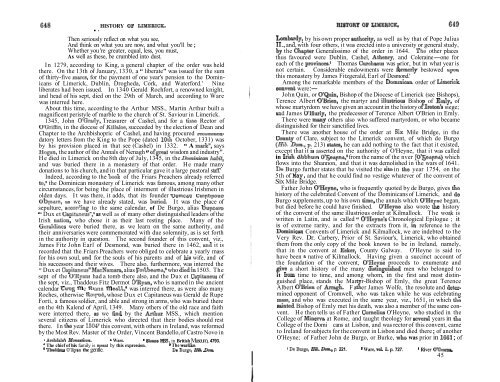
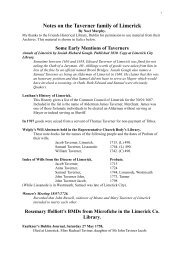

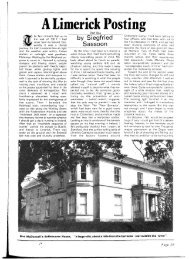
![The Galbally farmer [poem] by Darby Ryan - Limerick City Council](https://img.yumpu.com/24792577/1/190x260/the-galbally-farmer-poem-by-darby-ryan-limerick-city-council.jpg?quality=85)
